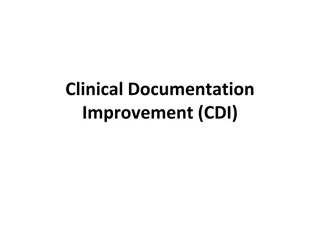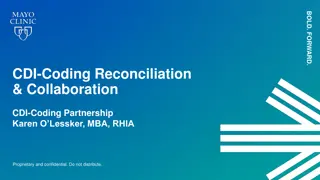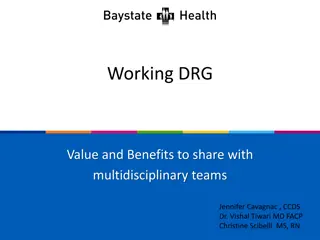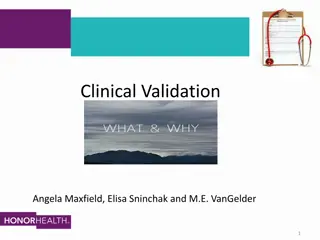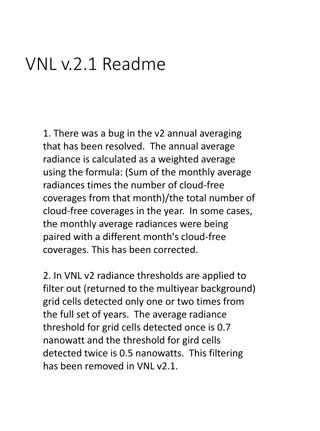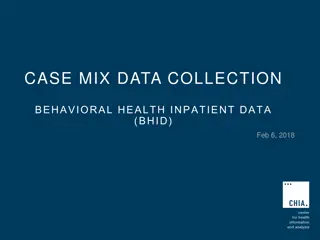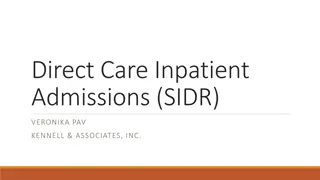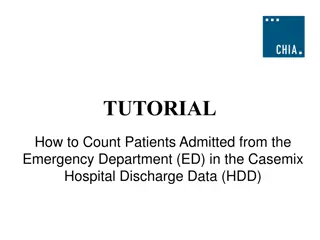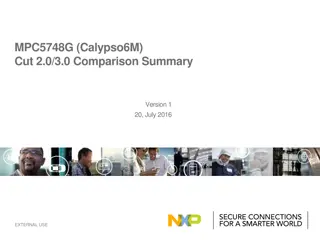Evolution of DRG Versions in Massachusetts Inpatient Data
This presentation delves into the history and evolution of Diagnosis Related Group (DRG) versions in Massachusetts Inpatient Hospital Discharge Data (HDD) from 2001 to 2013. It explores the different DRG versions available, such as VHAF-DRG, AP-DRG, APR-DRG, and CMS-DRG, detailing the changes and enhancements over the years. The significance and impact of these DRG versions on healthcare reimbursement and patient classification are also highlighted.
Download Presentation

Please find below an Image/Link to download the presentation.
The content on the website is provided AS IS for your information and personal use only. It may not be sold, licensed, or shared on other websites without obtaining consent from the author. Download presentation by click this link. If you encounter any issues during the download, it is possible that the publisher has removed the file from their server.
E N D
Presentation Transcript
Case Mix Questions Submitted by Users Slides from User Workgroups
What DRG versions available in CHIA Inpatient Case Mix Data? [from 2014]
Review: Definition of DRG Diagnosis Related Group A classification system that groups patients according to diagnosis, type of treatment, age, and other relevant criteria. Under the prospective payment system, hospitals are paid a set fee for treating patients in a single DRG category, regardless of the actual cost of care for the individual. Source: CMS http://www.cms.gov/apps/glossary/default.asp
Over the Past 30 years Multiple Versions of DRGs have been Created and Refined The Three Most Commonly Used DRGs Decade (2004-2013) in HDD All Patients Diagnosis Related Groups AP-DRG All Patients Refined Diagnosis Related Groups APR-DRG Medicare (CMS) Diagnosis Related Groups CMS-DRG
13 Year (2001-2013) History of Diagnosis Related Group (DRG) Versions in Massachusetts Inpatient Hospital Discharge Data (HDD) VHAF- DRG Version 24 VHAF- DRG Version 25 HDD Fiscal Year AP-DRG Version 12 AP-DRG Version 14.1 AP-DRG Version 18 AP-DRG Version 21 AP-DRG Version 25.1 APR-DRG Version 15 APR-DRG Version 20 APR-DRG Version 26.1 APR-DRG Version 30 CMS-DRG Version 26 CMS-DRG Version 27 CMS-DRG Version 28 CMS-DRG Version 29 CMS-DRG Version 30 2013 X X X X X X 2012 X X X X X X 2011 X X X X X X 2010 X X X X X X (available soon) 2009 X X X X X 2008 X X X X 2007 X X X X 2006 X X X X X 2005 X X X X 2004 X X X X 2003 X X X X 2002 X X X X 2001 X X X X
What is the difference between the DRG versions?
AP-DRG History and Massachusetts HDD Use Timeline All Patients Diagnosis Related Groups (AP-DRG) was developed in 1987 through agreement between New York State Department of Health and 3M Health Information Systems Software in conjunction with the National Association of Children s Hospitals and Related Institutions. AP-DRGs are similar to original DRGs developed by Yale University for CMS, but also include a more detailed DRG breakdown for non-Medicare patients, particularly newborns and children. Its development was driven by legislation instituting DRG-prospective payment for all non-Medicare patients and evaluated to ensure its applicability to neonatal, pediatric patients and patients with HIV. The features of AP-DRG categories recognize resource intensity* associated with: Six Distinct Neonate Birth Weight Ranges HIV in the presence or absence of 12 related infections Complications and Comorbidities / Transplant Status Differentiation of Forms of Substance Abuse Pediatric modifications associated with, for example, lead poisoning and congenital anomalies Timeline of AP-DRG Use in Massachusetts HDD 1989 - 2008 AP-DRG Version 12 1994 - 2006 AP-DRG Version 14.1 1994 - 2006 AP-DRG Version 18 2006 - 2013 AP-DRG Version 21 2009 - 2013 AP-DRG Version 25.1 Definition of Resource Intensity - The relative volume and types of diagnostic, therapeutic, and bed services used in the management of a particular disease. (source: AHRQ https://www.hcup-us.ahrq.gov/db/nation/nis/APR-DRGsV20MethodologyOverviewandBibliography.pdf)
APR-DRG History and Massachusetts HDD Use Timeline All Patients Refined Diagnosis Related Groups (APR-DRG), developed in 1990, shifts focus of DRGs from institutional resource intensity to case mix demographics, clinical complications and comorbidities, and multiple diagnoses. Existing resource intensity DRGs did not address severity of illness, risk of mortality, and the impact and interaction of multiple diagnoses on treatment difficulty. While CMS later created an MS-DRG severity adjustment to CMS-DRG, it only adjusts for single complicating factors while APR-DRG is more effective in grouping by the true complexity of multiple additional comorbidities or complications with and without their added impact on resource use. The APR-DRG includes: Focus of APR-DRG on interaction of factors Clinical Aspects Patient Characteristics ICD-9-CM Diagnoses Surgical Procedures Age Principal Diagnosis Secondary Diagnoses Gender Discharge Status Comorbidity Four severity of illness subgroups (Minor, Moderate, Major, Extreme) Four risk of mortality subgroups (Minor, Moderate, Major, Extreme) Each of the above subgroup assignments take into consideration secondary diagnosis, interaction between secondary diagnosis, age, principal diagnosis, complications, comorbidities, OR and non-OR procedures. Complications More than 50% of U.S. hospitals use APR-DRG. CMS contracted with RAND to evaluate severity-adjusted of 5 different DRG systems APR-DRG ranked superior to all other DRG classification systems.* Timeline of APR-DRG Use in Massachusetts HDD 1990 - 1999 APR-DRG Version 12 1994 - 2006 2007 - 2013 APR-DRG Version 20 APR-DRG Version 15 APR-DRG Version 26.1 2009 - 2013 2009 - 2013 APR-DRG Version 30 * Wynn BO, Scott M: Evaluation of Severity-Adjusted Systems. Prepared for the CMS July 2007, RAND Health.
CMS-DRG History and Massachusetts HDD Use Timeline The Health Care Financing Administration (HCFA), the predecessor agency to the Centers for Medicare and Medicaid Services, implemented HCFA-DRGs in 1983 to measure inpatient resource consumption by the Medicare population. The core of their DRG system was the healthcare product supplied by hospital care of a patient. The initial architects of the CMS-DRG system established 23 major diagnostic categories (MDCs) as the first level of categorizing these products.* The MDCs were then subdivided into DRGs based on factors such as surgical status, organ system, age, symptoms, comorbidities, and discharge status. While subsequent modifications to the Medicare DRGs included non-Medicare patients, the key focus of modifications has been on problems relating primarily to the elderly population. The Veterans Health Administration VHAF-DRG is based on the CMS-DRG with refinements by 3M for severity in the veterans population and non-veteran population. Timeline of HCFA, VHAF, and CMS DRG Use in Massachusetts HDD How CMS-DRGs differ from APR-DRGs?** 1988 - 1991 HCFA-DRG Version 2 Annual Updates VHAF- DRG Versions 24 25 CMS- DRG Versions 26 27 28 29 30 1988 - 2000 HCFA-DRG Version 8 * Source: Dr. Brandon Bushnell: The Evolution of DRGs. American Academy of Orthopedic Surgeons, http://www.aaos.org/news/aaosnow/dec13/advocacy2.asp ** Source: All Patient Refined DRGs, a Methodology Overview, 2006, 3M HIS, https://msmedicaid.acs-inc.com/trainingMaterials/MSAPR-Methodology.pdf
Comparison of Some Structural* Differences between Medicare-DRG, AP-DRG, APR-DRG Versions 12 Medicare DRG AP-DRG APR-DRG Multiple Complications and Comorbidities not recognized Multiple Complications and Comorbidities not recognize Multiple Complications and Comorbidities recognized Newborn Birthweight not Used Newborn Birthweight Used Newborn Birthweight Used No Risk of Mortality Subgroup No Risk of Mortality Subgroup Includes Risk of Mortality Subgroup National Association of Children s Hospitals Pediatric Modifications Not Included Limited Inclusion of National Association of Children s Hospitals Pediatric Modifications Complete Inclusion of National Association of Children s Hospitals Pediatric Modifications Limited use of HIV Infection MDC Complete use of HIV Infection MDC Complete use of HIV Infection MDC * Source: 3M Health Information Systems Research Report No. 5-98
If I want to identify the potential delivery records, which DRG is the best for me?
Comparison of Differences in CMS DRG Version 30 and APR DRG Version Top Ranking Delivery Groupings by Charges for Massachusetts HDD APR DRG 540 560 541 561 566 640 542 950 625 614 546 639 633 544 CMS DRG 766 Cesarean section w/o CC/MCC 775 Vaginal delivery w/o complicating diagnoses 765 Cesarean section w CC/MCC 774 Vaginal delivery w complicating diagnoses 767 Vaginal delivery w sterilization &/or D&C 776 Postpartum & post abortion diagnoses w/o O.R. procedure 781 Other antepartum diagnoses w medical complications 794 Neonate w other significant problems 982 Extensive O.R. procedure unrelated to principal diagnosis w CC 782 Other antepartum diagnoses w/o medical complications 768 Vaginal delivery w O.R. proc except steril &/or D&C 792 Prematurity w/o major problems 789 Neonates, died or transferred to another acute care facility 791 Prematurity w major problems 793 Full term neonate w major problems 769 Postpartum & post abortion diagnoses w O.R. procedure APR DRG* Version 30 DRG CMS Version 30 DRG Cesarean delivery Vaginal delivery Vaginal delivery w sterilization &/or D&C Postpartum & post abortion diagnoses w/o procedure Other antepartum diagnoses Neonate birthwt >2499g, normal newborn or neonate w other problem Vaginal delivery w complicating procedures exc sterilization &/or D&C Extensive procedure unrelated to principal diagnosis Neonate bwt 2000-2499g w other significant condition Neonate bwt 1500-1999g w or w/o other significant condition Other O.R. proc for obstetric diagnoses except delivery diagnoses Neonate birthwt >2499g w other significant condition Neonate birthwt >2499g w major anomaly D&C, aspiration curettage or hysterotomy for obstetric diagnoses Neonate bwt 2000-2499g, normal newborn or neonate w other problem Neonate bwt 2000-2499g w major anomaly Neonate, transferred <5 days old, not born here 626 621 580 * Note: APR DRG includes additional Subclass groupings by Category for Severity of Illness and Risk of Mortality
Comparison of CMS-DRG to APR-DRG for 4 Single Liveborn Cases* PDX V3000: Single liveborn, born in hospital, delivered without mention of cesarean section Admission age in days: 0 Discharge status: Home Birthweight: 500G Case 1 Case 2 Case 3 Case 4 Description Secondary Diagnoses 748.4 748.4 770.8 748.4 770.8 753.0 Congenital Cystic Lung Respiratory Failure of NB Renal Agenesis CMS DRG 391 390 389 389 Normal Newborn/ Newborn with other significant problems/Full Term Neonate w/ Maj. Prob. 591Subclass 3 591 Subclass 4 APR DRG 591 Subclass 1 591 Subclass 2 Neonate, birth weight 500-749G, without major procedure CMS DRG APR DRG 0.2560 0.1134 0.2892 2.6320 0.6430 12.8901 0.6430 23.1141 Payment weights** * Source: Lisa Lyons, An Overview of 3MTM All Patient Refined Diagnostic Related Groups (3M APR DRG), July 13, 2012, 3M HIS **Payment weights are budget neutral and computed from a national database
Comparison of CMS-DRG to APR-DRG for Preterm Infant* * Source: All Patient Refined DRGs, a Methodology Overview, 2006, 3M HIS, https://msmedicaid.acs-inc.com/trainingMaterials/MSAPR-Methodology.pdf
QUESTION Is it possible to determine race/ethnicity of a patient? ANSWER In the APCD, the eligibility file has race and ethnicity data but the completeness of that varies across carriers. [Thresholds for Race and Ethnicity are both 3%] Case Mix data has more complete race and ethnicity data
APCD / Case Mix User Questions QUESTION I am looking to get a comprehensive report that tells me what is the cost of a procedure when it is done in different locations / facilities / hospitals within MA. Where can I get this data? ANSWER If you are looking for the charges associated with different procedures performed at acute care hospitals, you should apply for Level I case mix data.
Question: What Type of Data is available in Case Mix on Substance Abuse Care? From 2014
Change in Massachusetts Inpatient Hospitals Discharges by Age and Diagnosis from FY2011 to FY2013 2011 to 2013 Percent Change 2011 2012 2013 Total Discharges Massachusetts Residents Non-Massachusetts Residents Residency Unknown 804,993 47,865 349 781,351 48,098 420 757,708 48,176 255 -5.9% +0.6% -26.9% Percent Increase from FY2011 to FY2013 Total Discharges by Age 0-17 years 18-24 years 25-34 years 35-44 years 45-64 years Semi-private (Medical or General) - Detoxification 116,908 40,136 83,634 72,866 212,105 326,538 112,801 38,763 84,687 71,043 210,151 312,423 110,766 36,540 83,191 66,961 202,312 306,369 35,445 Days -5.3% -9.0% -0.5% -8.1% -4.6% -6.2% 2011 2012 2013 Room & Board Private and 33,577 Days 36,161 Days 5.6% 65 years and older Births Inpatient Discharges 7,951 8,928 8,924 12.2% Single Births Twin Births Multiple Births 69,481 3,158 111 68,685 3,012 74 68,512 3,020 108 -1.4% -4.4% -2.7% Average Length of Detox 4.22 Days 4.05 Days 3.97 Days -5.6% $21,195,330,387 $20,933,822,349 $21,895,933,982 -3.3% Total Fiscal Year Inpatient Charges Increases in Selected Inpatient Services Psychiatric Bed/Private Psychiatric/Semi Private Detoxification Bed/Private Detoxification/Semi Private Drugs Require Specific ID $ 519,873,229 $ 40,752,757 $ 21,416,094 $ 8,205,278 $ 8,654,748 $ 33,553,555 $ 524,614,802 $ 531,882,704 $ 40,980,932 $ 46,746,425 $ 22,956,404 $ 23,950,917 $ 9,895,825 $ 8,157,579 $ 61,125,541 $ 103,314,446 $ 23,980,525 2.3% 14.7% 11.8% -0.6% 1094% -29% $ 23,936,856 Psychiatric/Psychological Treatment and Services Note that Case Mix is limited to acute care hospitals. Psychiatric and substance abuse specialty hospitals to do not submit Case Mix data to CHIA.
User Question: Lack of Discharge Date in Outpatient Observation (OOA File) Question: Observation data doesn't have a "Discharge date" variable, but has Begin_date and End_date. Answer: Observation Stay Data doesn t use discharge date because patients are not admitted to Observation Stay. It is an just an outpatient stay with legally different payment rules. So the dates you would analyze for the beginning of the stay is Begin_date and the end of the stay End_date.
User Question: Significant Procedures in Case Mix Files Question: Do Significant Procedures when described on the Case Mix data application for Level 5 data denote that the dates of admission and discharge are provided for the significant procedure only (and not the associated procedure) or does it denote something else?
User Question: Significant Procedures in Case Mix Files Answer: In addition to admission date and discharge date, inpatient case mix contains distinct date fields for every procedure field. The date field is the date when the procedure was actually performed. The rule for procedure dates is that they must not be earlier than 3 days prior to date of admission date unless admission source code is ambulatory surgery or observation stay. The difference between the principal procedure and the associated significant procedures is that the principal procedure the procedure most related to the principal diagnosis and performed for definitive treatment of the principal diagnosis rather than for diagnostic or exploratory purposes, or necessary to treat a complication of the principal diagnosis. The significant procedures are procedures which carry an operative or anesthetic risk or require highly trained personnel, special equipment or facilities.
Question: Why are there Zero Charges on Thousands of Case Mix Outpatient Emergency Department Records? Answer: Over the past 7 years, 92% of the zero charge ED visit records are for patients who eloped, 7% for patients who left against medical advice and 1% percent for patients who met with their person physician. FY2007 FY2013 Age Distribution of Patients with Zero Charges who Elope or Leave Against Medical Advice (Approximately 25% attributable to those between ages 18 to 26 years old)
Question: If a patient is admitted from the ED or Observation Stay (OS), we understood that their services are rolled into their case mix inpatient record and will not appear in the ED or OS data release. If that is truly the case, what does OS Departure Status = 2 (Admitted to Hospital) mean? Answer: Medicare guidelines indicate that Code 2 is used when the hospital is aware of a planned admission even if it doesn t occur immediately after the discharge. CHIA was able to corroborate that, yes, Code 2 patients were admitted, some to the same hospital, some to different hospitals, and some not immediately after they end their observation stay. In the table below, you will see that the use of OS Code 2 has escalated in the past two years. Even with the partial calendar year 2013 data, the number is higher than previous years. Oct Dec Data Pending
Question: Even though the ED Visit Rate has decreased since FY2012, the FY2014 ED Visit data shows a 24% increase in the ED Death Rate and 26% increase in the Dead on Arrival rate. Is that data accurate? Answer: Hospitals review and return validation reports before CHIA releases their data. For ED Deaths, part of the increase may be attributable to deaths associated with substance abuse disorders, alcohol-related disorders, and severe open head injury wounds. For dead on arrivals, we did identify an anomaly in the use of the DOA code in FY2014 and FY2013 with a shift in reporting in ED death volume to dead on arrivals. Our State Medical Examiner s criteria for a dead on arrival is a patient who arrives in asystole, with no cardiac electrical activity, meaning no blood is flowing to the brain or other vital organs. Based on FY2010 FY2014 ED data, most DOAs have an LOS less than 15 minutes. The anomaly is in the length of stay for DOAs exceeding an hour suggesting an ED Death instead of a DOA. FY2010 to FY2014 Aggregated DOA Volume by Length of Stay Length of Stay LOS > 1 hour Dead on Arrivals* LOS < 1 hour * Small DOA Cells Suppressed
https://www.cambridgema.gov/~/media/Images/veteransservicesdepartment/Misc%20Photos/veteranflag.ashxhttps://www.cambridgema.gov/~/media/Images/veteransservicesdepartment/Misc%20Photos/veteranflag.ashx Question: Does CHIA have any data at all on Veterans? Answer: Hospital inpatient discharge case mix data contains a Veterans Status indicator. This field code indicates the patient s status as a United States veteran. FY2012 to FY2014 Veterans Inpatient Discharge Volume The recent decrease in Veteran Inpatient volume has paralleled the over decreasing trend in inpatient utilization. FY2012 FY2013 FY2014 Distinct VA Patients 43,423 42,815 39,807 Total VA Inpatient Discharges 67,426 65,605 61,234 Also, MA APCD Medical Claims reflects the portion of payments made by private carriers for medical care provided at VA facilities.



